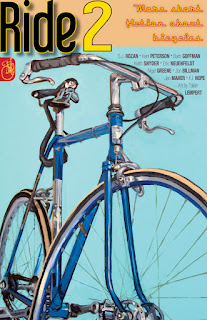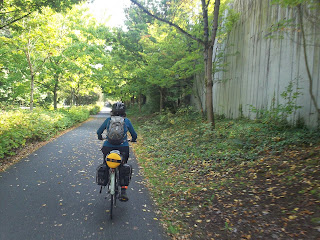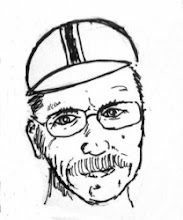I don't know what on earth I was
thinking when I agreed to this. I might have been imagining how
beautiful it is out on the Olympic Peninsula, how wonderful it would
be to spend ten days with Kent, riding our bikes on roads less
travelled in early fall when the weather is cool and the leaves
beginning to turn, camping by the water in our excellent little tent
and watching beautiful sunsets every night. But when Kent suggested
we ride to Seattle from our home in Issaquah instead of taking
advantage of the bike racks on Sound Transit, and I agreed to try it,
I don't know what I was thinking.
Yes, I knew it would involve a long and
arduous climb. I knew I'd be riding in a lot more traffic than I am
used to. And I knew that there would be bridges to cross, most
notably the long I-90 floating bridge that links Mercer Island with
Seattle. But I was feeling brave and adventuresome, and I agreed to
try it. Now that I have survived the long ascent out of Issaquah and
the harrowing descent of Honda Hill and we're making our way along
the trail through the Bellevue Slough, I am well aware that I am
already very tired and there is some very hilly terrain ahead, and I
have used up whatever bravery I started out with going down that hill
with trucks roaring by, and the dreaded I-90 bridge is still to come.
Of course there is a smaller bridge to cross before this, and as we
start to roll across it, I am tense and seriously worried that I
have bit off more than I can chew. And what I am thinking is, can we
maybe catch the bus with bike racks at the Mercer Island Park &
Ride?
Suddenly Kent calls out from behind me.
“Look, a heron!” I stop on the bridge, and sure enough, there
it is, a blue heron standing still at the edge of the water on its
long legs, searching for signs of living things moving in the depths.
I have a sort of history with herons,
odd as that sounds. Years ago, living in White Plains, New York and
raising two small children, during rare hours of time to myself I'd
wander over to a small pond not too far from where we lived. There
was a heron who fished there, standing very still in the water,
waiting, its beak occasionally darting at amazing speed beneath the
surface. I'd sit on the grassy bank and watch the water, watch the
heron, watch the clouds, reveling in the peace and quiet, coming back
to myself within my days spent as wife and mother. When we moved to
Issaquah, I knew I would miss that place, and I would miss the heron.
But a salmon stream flows through the center of Issaquah, and one
morning as I was walking to work in the early darkness, I saw a tall,
slender distinct bird-shape, motionless in the moving water. I stood
on the bridge over the creek, quiet and delighted. The heron looked
up at me, and returned to its fishing. I came to look forward to
seeing the new heron on my early morning walks, and I often did. I
would stand for awhile on the bridge, cherishing those moments of
pre-dawn companionship, listening to the sound of the creek and
looking up at the stars while the heron fished for its breakfast.
What grace a heron has, to venture on
slender legs into deep waters, to wait, still and patient, as water
swirls around, scanning the depths, perpetually seeking. And yet in
flight, they are magnificent, their extended slender bodies, long
beaks, and wide blue wingspan evocative of prehistoric ancestors as
they soar. Our four-year-old son, in a stage of fascination with
dinosaurs, once saw a heron in flight and pointed excitedly.
“Pteranodon!” His dad said gently. “No, Peter, that's a
heron.” But Peter remained convinced that he had seen a
pteranodon, and I'm still not sure he was entirely wrong.
A few years ago, I had ventured out
into deep waters of my own, exploring a sense of call to ordination
in my church. It is a lengthy and arduous process, which involves
evaluation by committees and commissions and boards and so forth at a
number of distinct stages. Many questions are asked, and one that
was asked of me was: “Are you willing to drive?” What might
have been a no-brainer for most people was deeply challenging for me.
Having lived car-free with my husband for over two decades, I had to
ask myself if that was something I was willing to change, and it was
not a small question.
I am convinced that the ways we choose
to get around in the world are deeply formative for us. They shape
how we experience the world, and how we experience ourselves in the
world. They dictate the pace at which we live our lives, they expand
or limit our range, our options, and our vision. At least as
significantly, the choices we make impact and shape the world around
us, for good or ill. Even if we fancy ourselves drivers, we
ultimately are all passengers on this fragile blue-green world that
sustains our lives as we travel around our star.
I mulled the practical questions. How
would I visit hospitals, respond to midnight emergencies, visit
people in their homes? In theory, a church that pays significant
lip-service, at least, to the responsibilities of environmental
stewardship should not be adverse to hiring a walking, biking,
public-transportation-using priest. But those ways of getting
around, at least on the average, take significantly more time than
simply hopping in the car. If I am accustomed to a slower pace of
life, the average parishioner today is not, and I suspect that most
would not be willing to adjust their expectations for response time
to their pastoral needs, especially if they are paying for that time.
Of course, Jesus did not drive, and except for a few journeys in
boats and a notable ride on a donkey, spent his entire public
ministry walking from place to place. It strikes me as odd that
people talk a lot about emulating what he did, but not the pace at
which he did it, or the mode of travel that enabled those
life-changing personal encounters with a woman who reached out to
touch the fringe of his garment, a blind man that cried out to him in
passing, or a short tax-collector who had climbed a tree to get a
better look at him. Paul did not drive either, and managed to spread
the gospel throughout the then-known world, covering over 10,000
miles between his own life-changing encounter with God on the road to
Damascus and his martyrdom at Rome. In fact, for the vast majority
of the church's history, people have celebrated, preached and
attended worship services, and have been baptized, counselled,
married, and buried without the involvement of the automobile. But a
sense of history is a rare thing these days, and as I say,
expectations have changed. The work I hope to do is work to which I
believe I am well-suited and called, and driving is something that
most people would not think twice about. Maybe I need to be more
adaptable in order to get where I hope to go. Yet I have never
believed that the end justifies the means; I find it much more likely
that the means determine the end, and I'm not convinced that our
collective reliance on automobile transport is achieving more good
ends than otherwise.
I think about the life Kent and I have
shared, the many ways we have chosen to live simply and travel slowly
and the relationship forged over decades by those choices. I know
many couples live happily even as one person drives while the other
does not. But I also know that there are threads you pull that can
unravel fabric faster and more irrevocably than one intends, bridges
we cross that lead to places we only belatedly realize we did not
want to go. I do not doubt that we would continue to love one
another. But if I were to decide to drive, our relationship and our
lives would be changed more fundamentally than by any choice we have
made yet, except for the decision to have children. To at least some
degree, we would travel at different speeds, in different orbits far
less synchronous than the ones shaped by our very real but
complementary differing interests and occupations. One can love a
comet that passes every few years into one's view in the night sky,
but that kind of love does not sustain a life together on the earth.
How can I place at risk the most precious thing in my life?
I have been pondering the “Are you
willing to drive?” question, and all that hinges on however it will
eventually be answered, for weeks. I am turning it all over again in
my mind as I wander home from work on a partly wooded trail, when a
sudden stunning cry fills the air and a streak of blue wings fills my
vision. The heron soars past me, so close I could reach out and
touch. Awestruck, I follow his flight with my eyes, my own heart
soaring as he turns and ascends on the wind, disappearing over the
tops of cedars, flying back towards the creek. I would have missed
this, is the thought that comes to me unbidden, and there is no
longer a question. I know that I will not drive.
It was probably a thread I pulled that
began the unraveling of my ordination process; I will never know for
sure. Eventually, I turned aside from a path that promised to become
increasingly adversarial, fraught with misunderstandings and dictated
by an agenda that had nothing to do with who I was or what I had to
offer. I got a green bike and headed out on another road.
All this I am thinking, all of it
brushing my mind as swiftly as wings, as I stand on the bridge over
the Bellevue Slough, watching the heron scanning the depths of the
water. I know that eventually, he will find what he is seeking, or
something better. And what I am also thinking now is that yes, I
really can do this. With a last glance at the heron, I smile and get
back on my green bike, heading across the bridge with Kent for the
great I-90 floating bridge, Seattle, and points beyond.





























































